Every engineer involved with analog circuitry details – as well as those doing high-level system performance analysis – is aware of the effects of the various temperature coefficients of critical component parameters. Two of the most important are the coefficient of thermal expansion (CTE) and the temperature coefficient of resistance (TCR).

Figure 1: In the gridiron pendulum, the differences in CTE between rods of two metals are used in an arrangement whereby the rods slide “against” each other and so cancel out most of the change in pendulum length; A is the exterior schematic, B shows rod lengths at normal temperature, and C is the same at higher temperature. (Image source: Wikipedia)
These temperature-induced shifts are unavoidable since they are a consequence of the basic laws of physics and materials science. Although CTE and TCR numbers are usually fairly small, they can still have a significant impact on high precision or high-frequency designs. Designers deal with these shifts in specification by using materials and components with as low a CTE or TCR as possible, or by using clever topologies which largely cancel and thus minimize their impact.
Engineers, scientists, and mechanics have known about CTE and its implications for centuries. John Harrison, who built the superbly accurate, prize-winning pendulum-based clock in the mid-1700s identified CTE as an error source, changing the length of the pendulum which was the basis for the clock period oscillator. Even though the CTE of metals is tiny and not noticed in normal life, it was a significant error source for the navigational clock he was building.
To overcome this error, he used a gridiron (also called “banjo”) pendulum with two dissimilar metals, such as zinc and iron, in a frame arrangement (Figure 1). As the temperature changed, the rods would slide along each other and thus cancel the effect of CTE to a large extent.
Another challenging effect of CTE is not the dimensional change itself, but the difference in dimensions which can occur when two materials are joined. In extreme cases, the joint can crack from the strain induced by the stress caused by these changes. Even when there is no immediate gross fracture, repeated thermally induced cycling can cause a joint to weaken (fatigue) and develop microscopic cracks which eventually lead to failure. For many cases, matching the CTEs is as important as their actual values.
TCR impact: beyond physical dimensions
For precision electronics when interfacing with sensors, TCR results in errors due to shifts in factors such as the value of gain-setting resistors or bias currents and offsets. In the clock pendulum, the clever design uses paired resistors on a common substrate with almost identical TCR in a differential circuit, causing the TCR drifts to largely cancel each other out.
There are many times, however, when such schemes aren’t practical and so a deeper look into basic material science is needed. For example, a standard resistor, such as that used for a pull-up, has a TCR of roughly 1000 parts per million (ppm)/⁰C. If this resistor is used as a current sensing shunt resistor, the self-heating due to unavoidable I2R effects would result in large shifts in the resistor value. This would in turn cause errors in the current measurement which is based on the simple I= V/R relationship.
Among the solutions to this potential problem is to use a physically larger resistor with larger thermal mass to reduce the effect of TCR, or even measure the resistor temperature to develop a correction factor. However, these are costly in terms of direct component cost, board space, and complexity. Instead, manufacturers have devised specialized current sense resistors based on unique—often proprietary—materials and fabrication techniques to create resistors with extremely low TCR.
For example, the LVR03R0100FE70 resistor from Vishay Dale features a TCR as low as ±50 ppm/⁰C for 0.1 ohm (W) to 0.2 W values. This is over an order of magnitude lower than the TCR of a commodity resistor, and specialty current sense resistors are available with TCRs down to a few ppm/⁰C for high precision applications.
Turning shortcomings into advantages
Innovation often involves taking what is a disadvantage and turning it into a useful attribute. Many decades ago, engineers used the disparities in the CTEs of different metals to construct the temperature-driven bimetallic switch, a simple strip with contacts (Figure 2). As the strip bends or straightens due to temperature changes, the end contact makes and breaks contact with a corresponding fixed contact. This design was used in some thermostats, and when wound with resistance wire, used as an overcurrent cut-off:
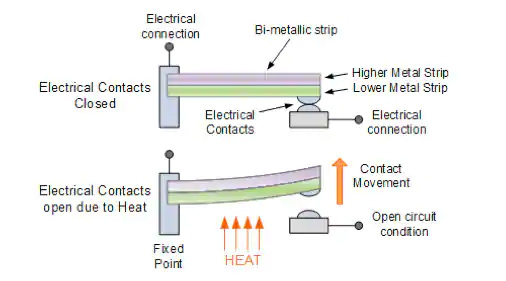
Figure 2: A bimetallic strip acts as a simple but effective temperature-driven on/off electrical switch. (Image source: Chegg Inc.)
In one widely used thermostat design, the bimetallic strip is wound in a spiral, and a sealed mercury switch is attached to the end (Figure 3). This eliminates contact bounce, sparking, corrosion, and wear over time and on/off cycles. Millions of thermostats based on this simple and effective approach were produced for home use, typified by the classic Honeywell thermostat. Don’t worry about the reliability of its all-mechanical design, as it has been extensively field-proven to work without problems for 30, 40, or more years.
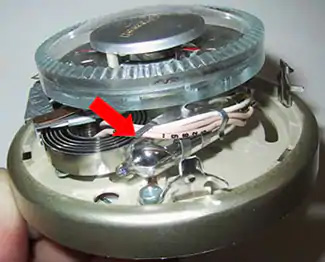
Figure 3: By winding a bimetallic strip in a spiral and using a sealed mercury switch (arrow) at the end, rather than exposed contacts, this thermostat design has proven to be a reliable, low-cost unit for consumer use. (Image source: Parallax Forum Inc)
Designers have also leveraged TCR, which is normally considered to be a detrimental characteristic, to create useful components. Thermistors are resistive temperature sensors that depend on large TCRs and the ability to produce materials with consistent nominal resistance and TCR values. For example, the Texas Instruments TMP6131DECR is a two-terminal, silicon-based passive device with a positive temperature coefficient (PTC) and a very high TCR of 6400 ppm/°C at 25°C. Its resistance increases dramatically as the temperature rises; note the slight nonlinearity of the response, largely due to the fact that TCR is a function of temperature (Figure 4). Most thermistors have much higher nonlinearity than this device.
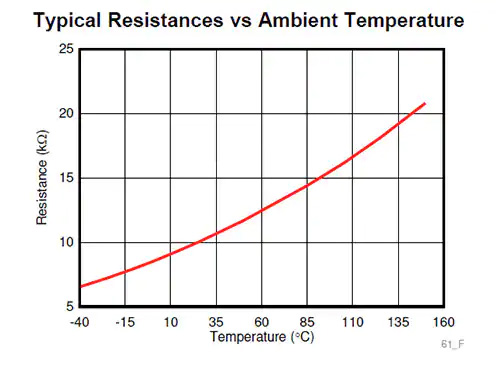
Figure 4: The curve of resistance versus temperature for the TMP6131DECR shows both its high sensitivity and slight nonlinearity. (Image source: Texas Instruments)
The well-known ideal diode law also has major temperature implications, as it defines the relationship among various diode parameters (Figure 5). Its temperature aspect can instigate many problems in circuit design, but it is also used as the basis for a solid-state temperature sensor.
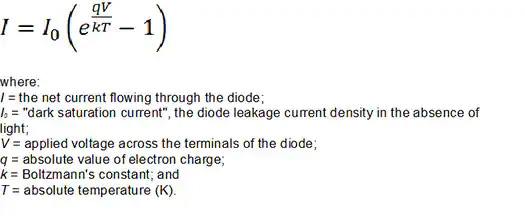
Figure 5: The ideal diode equation defines the consequences of the values of key parameters on the current flow of a saturated diode. (Image source: PV Education)
For example, the TMP36GT9 from Analog Devices is an easy-to-use analog output temperature sensor in a three-terminal TO-92 package (Figure 6). At its core is a current source with a current output that is a linear function of absolute temperature (K). The IC has an internal buffer that converts the current to a voltage, yielding an output of 10 millivolts/°C from -40°C to 125°C.
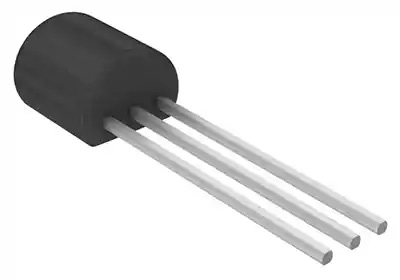
Figure 6: Simple to use and accurate, the TMP36GT9 three-terminal temperature sensor from Analog Devices produces a clearly defined 10mV/°C analog output. (Image source: Analog Devices)
Going beyond CTE and TCR
Even the humble and often taken-for-granted printed circuit board (pc board) has temperature-related considerations. The very widely used FR4 laminate has CTE values of 14, 12, and 7 ppm/⁰C along its x, y, and z axes, respectively. These are very low numbers, but may be excessive where the board is a circuit element as is the case in many RF designs. As such, board materials are available with CTEs which are about 20% to 30% lower.
Although CTE is the most apparent manifestation of temperature-driven pc board changes, the temperature-related performance of other parameters is also a consideration in the multi-gigahertz (GHz) spectrum. Consider the fundamental parameter of dielectric constant εr (sometimes denoted as Dk, and closely related to relative permittivity). This metric defines the ratio of the capacitance of a capacitor filled with the given material to the capacitance of an identical capacitor in a vacuum without the dielectric material.
In many higher frequency RF designs, the pc board is used as a capacitive circuit element, forming LC filters, microstrip transmission lines, and more. As it is certainly an unavoidable parasitic element, the nominal value of εr is critical, as is its temperature stability. Due to variations in both moisture absorption and dimensions due to temperature changes, the common FR4 laminate has only moderate stability (not surprisingly, cheaper phenolic is worse).
To address this problem, vendors of circuit board material have developed laminates with more consistent εr specifications, (Figure 7). The graph compares two of their ceramic filled, PTFE (Teflon)-based laminates with a PTFE-only board.

Figure 7: This graph of dielectric constant εr for three advanced non-FR4 laminates shows their variation for that parameter versus temperature, an effect that has major implications in multi-GHz designs. (Image source: Rogers Corp.)
The R03003 version shows very little change in εr from -50⁰C to 150⁰C, while the pure PTFE board, which is recognized for its excellent dielectric properties, including low leakage current, has a significant and nonlinear variation. The R03035 laminate is not as good as the R03003 but is far better than the PTFE material.
Conclusion
Temperature coefficients have always been a concern in designs ranging from precision analog front-ends to RF oscillations – think of a crystal oscillator stabilized in a temperature-controlled oven. Designers fall into two groups: those who can work out techniques to accommodate, minimize, or cancel the detrimental effects of temperature changes, and those who figure out how to take advantage of these changes in new and innovative ways.
